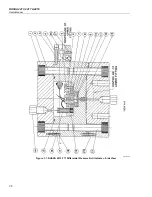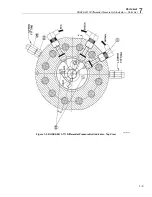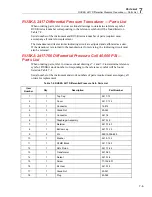
5-1
Chapter 5
Performance Observations
Actual Sensitivity versus Apparent Sensitivity
Although the differential pressure indicator is regarded as a null-indicating instrument,
the degree to which a true null may be achieved depends upon the readability of the error
signal displayed on the meter. In order to obtain a readable error signal, the diaphragm
must move. The sensitivity of the instrument is expressed as the change in pressure
divided by the corresponding change in meter reading — the change in meter reading
being a function of the motion or displacement of the diaphragm. The sensitivity must be
determined in such a way that the tension in the diaphragm, resulting from the applied
pressure, is the only restoring force which re-establishes equilibrium
When one side of the diaphragm is opened to atmosphere and a small increment of
pressure is applied to the other side, the diaphragm will move under the influence of the
applied pressure. The motion will continue until the forces tending to move the
diaphragm are equally opposed by the forces of tension in the diaphragm tending to resist
the motion. The sensitivity is then equal to
Δ
P divided by the change in meter reading.
When one side of the diaphragm is connected to a single-ended system containing a gas
under pressure, the circumstances are different. The forces of an applied pressure
increment tend to move the diaphragm as before, but the forces resisting the motion are
greater than before. As the diaphragm moves, the volume of the single-ended system is
reduced and its pressure increased. The
Δ
P that was applied to the diaphragm is
automatically diminished and the instrument sensitivity appears to be less than before.
An example of the extreme case is one in which the single-ended system is completely
filled with a non-compressible liquid. As the pressure is increased on the opposite side of
the diaphragm, the liquid will not permit the diaphragm to move. In this instance, the
sensitivity will appear to be very poor, but the actual sensitivity is no different than when
measured under ideal conditions.
Calibration
The calibration procedure consists of determining the pressure coefficient of the
transducer, the maximum sensitivity, and the zero shift that accompanies alternate
over-ranging pressures on the diaphragm.
The pressure coefficient is usually small — on an average, being less than 10-5/psi.
When the transducer is used in a bi-fluid system, for the calibration of elastic
pressure-measuring devices, the error of the transducer can often be disregarded. When
used in an apparatus for basic PVT studies, the coefficient is significant and its
expression is of more value if reported in units of diaphragm displacement per unit of
pressure level rather than as a change in pressure differential per unit of pressure level.
For very small samples, the displacement of the diaphragm can result in an intolerable
















































